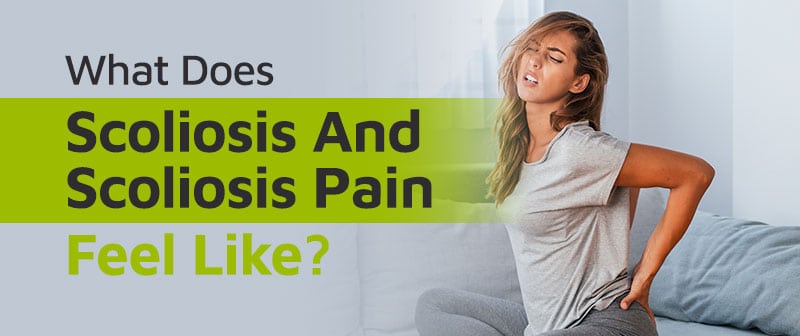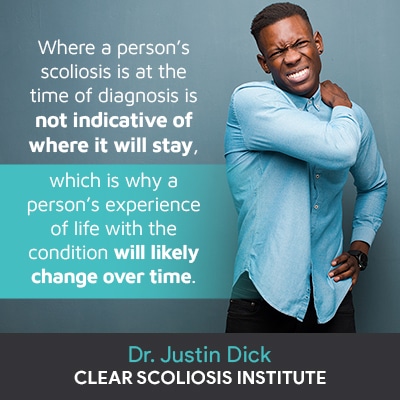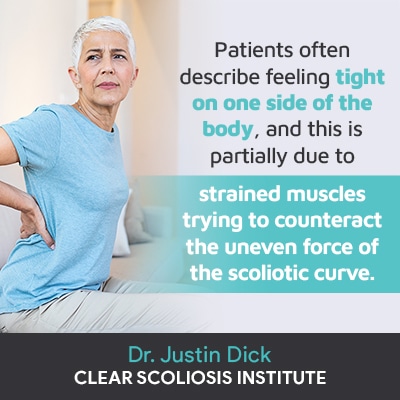
Scoliosis and scoliosis pain will feel different from one patient to the next. Factors like patient age, causation, curvature location, and condition severity will shape a person’s experience of life with the condition. Particularly when it comes to pain, scoliosis feels very different for young patients who are still growing, versus adults.
Scoliosis is a highly variable condition that can range from mild to moderate and severe, which is why there is no one-size-fits-all description of what it feels like to have scoliosis; each patient’s experience is unique and shaped by a number of important patient/condition variables.
Let’s start our discussion of what it’s like to live with scoliosis, and how condition-related pain is described, by first touching on the important patient/condition variables that factor into how a condition is going to feel for the patient.
If a person is diagnosed with scoliosis, this means they have an unnatural sideways spinal curvature, with rotation, and a minimum Cobb angle measurement of 10 degrees.
Scoliosis is not a static condition; it’s progressive, meaning it’s in its nature to worsen over time, especially if severe and/or if left untreated.

In addition, there are many different types and severity levels of scoliosis, making the experience even more patient-specific.
When it comes to diagnosing scoliosis, the process involves comprehensive assessment to further classify conditions based on important patient/condition factors such as patient age, causation, curvature location, and condition severity; these same classification points play a large role in shaping a person’s experience of life with the condition.
In the context of what scoliosis feels like and whether or not it’s painful, patient age is a big determining factor.
Patient age is important not just because it indicates overall health and fitness, but also whether or not scoliosis is a compressive condition.
While somewhat of a simplified explanation, in children and adolescents who are still growing, their spines are undergoing a constant lengthening motion, and this counteracts the compressive force of the unnatural spinal curve; however, in adults who have reached skeletal maturity, their spines have settled due to gravity and maturity, and the condition becomes compressive as the spine and its surrounding ligaments, muscles, and nerves are exposed to uneven pressure.
Compression is the main source of condition-related pain, so patient age is an important factor when it comes to how the condition will feel and what it will be like to live with.
Patient age is also important because growth is the condition’s number-one trigger for progression, so while an adolescent is less likely to find scoliosis as painful as an adult, they are more at risk for rapid-phase progression, due to the stage of puberty and its rapid/unpredictable growth spurts.
Causation refers to a condition’s etiology, meaning the reason behind its development.
Part of the reason scoliosis is so often deemed complex and/or mysterious is because we don’t fully understand its causation.
In fact, a staggering 80 percent of known diagnosed scoliosis cases are classified as idiopathic, meaning the condition is not associated with a single clear causative source.
Another reason is that there are different types of scoliosis a person can develop. The remaining 20 percent of known diagnosed scoliosis cases fall into one of the following classifications: neuromuscular, congenital, degenerative, or traumatic scoliosis.
So depending on the type of scoliosis a patient is diagnosed with can also factor into how it is going to feel and whether or not pain will be a symptom.
There are three main spinal sections: cervical (neck), thoracic (middle/upper back), and lumbar (lower back).
Scoliosis can develop anywhere in the spine, although the thoracic section is most commonly affected.
Curvature location can help predict some likely symptoms; for example, with thoracic scoliosis, the unnatural curve’s pull on the rib cage can cause the development of a rib arch.
The appearance of a rib arch can range from subtle to overt, and depending on condition severity and the angle of trunk rotation (ATR), can also cause chest discomfort and respiratory issues.
When it comes to how a person’s scoliosis is going to feel, condition severity is a crucial factor.
As mentioned, scoliosis can range from mild to moderate and severe, and this is determined by a measurement obtained via X-ray: Cobb angle.
A patient’s Cobb angle tells me how far out of alignment a scoliotic spine is and places a condition on its severity scale of mild, moderate, or severe:
Again, while every case is different, in general, the more severe a condition is, the more likely it is to cause noticeable symptoms such as postural changes and pain.
In mild forms, particularly for adolescents, it’s not uncommon for the condition to go unnoticed as it doesn’t always cause functional deficits, noticeable postural changes, and/or pain.
So for many people, scoliosis is not overly painful, but for others with severe forms, and particularly for adults, the condition can cause a wide range of back and/or radicular pain felt throughout the body.
Now that we have addressed the specific patient/condition variables that shape a person’s experience of life with the condition, let’s answer some common questions regarding condition-related pain.
As scoliosis progresses, this means the abnormal spinal curve is increasing in size, and the uneven forces the body is being exposed to are also increasing.
It’s not uncommon for patients with scoliosis to describe a feeling of being stiff on one side of the body, and this is understandable as spinal rigidity increases with progression.
In addition, it’s not just the spine that’s charged with maintaining its natural and healthy curves and alignment; it’s also the spine’s surrounding muscles that provide it with crucial support and stabilization.

Scoliosis patients also commonly describe a feeling of being weighed down, or pulled down.
When an unnatural spinal curve is present, the body’s overall symmetry is disrupted as the spine’s health, function, and biomechanics are disrupted; this can cause the arms and legs to hang at different lengths, clothing to become ill-fitting, and the sensation of being weighed down.
The sensation of the body being pulled down and stretched is further understood as the result of adverse spinal tension and resulting compression.
The feeling of being pulled down and to one side can also be a common feeling as the body tries to adjust to its shifting center of gravity; as the spine runs through the center of the body, if that spine is unnaturally curved to one side, it makes sense that that shift would cause the feeling of being pulled to the side.
As mentioned, not everyone with scoliosis is guaranteed to experience pain, but for those that will, what should they expect?
What Does Scoliosis Pain Feel Like?
Once a condition continues to become compressive in adulthood, it can cause varying levels of back pain that range from mild and intermittent to chronic and debilitating.
Again, factors like patient age, curvature location, type, and condition severity will factor into just how painful a condition is, but in general, pain is the number-one scoliosis symptom that brings adults in to see me.
As mentioned, scoliosis doesn’t just expose the spine to compression, but also its surroundings, and when it comes to how painful scoliosis is, the answer is often related to the degree of nerve involvement.
Remember, nerves are like branches on a tree, fanning off in multiple directions, so a spinal nerve that’s irritated can cause radicular pain felt far from its site or origin.
So can scoliosis cause back pain? Yes, it most certainly can, to varying degrees.
Nerve-related back pain is regarded as one of the most debilitating forms of back pain and can feel like a sharp stabbing pain, electric-like shocks, tingling, and/or numbness.
General back pain can be experienced as extreme tightness due to spinal rigidity, and this can be exacerbated by surrounding strained muscles being exposed to uneven wear.
While scoliosis in children and adolescents isn’t commonly associated with back pain, approximately 20 percent of adolescents still report issues with muscle pain.
Scoliosis is also closely associated with headaches, with the potential of reaching migraine status; this is understood as the result of cerebrospinal fluid (CSF) irregularities.
The spinal cord’s central canal is the channel through which CSF flows; if the spine has an abnormal curvature, it can disrupt that flow, and this can cause CSF pressure in the brain to drop, causing headaches of varying degrees.
People also ask, can scoliosis cause tailbone pain, and the general consensus is that while it can be a contributing factor, particularly with lumbar scoliosis and/or when nerves are irritated, coccydynia is more closely related to spinal injury/trauma.
When giving a scoliosis diagnosis, it’s not uncommon to be asked, “What does scoliosis and scoliosis pain feel like?”
While I would like to give patients, and their families, a clear-cut answer, the truth is that each experience of life with scoliosis is as unique as the patient. Just as their treatment should be.
For young patients who have not yet reached skeletal maturity, it’s not uncommon for the condition to go unnoticed, particularly in mild forms, but for adult patients, condition-related pain is a telltale sign of scoliosis.
While scoliosis is not commonly associated with back pain in young patients, muscle pain and/or headaches can become an issue, particularly if left untreated.
For adults, scoliosis pain can include headaches, muscle pain, back pain, and radicular pain felt throughout the body (most commonly the legs and feet).
As a CLEAR-certified scoliosis chiropractor, I address a patient’s condition-related pain by addressing its underlying cause: the condition itself.
As a believer in the merits of proactive treatment, I see the opportunity to treat conditions while still mild as a chance to keep them that way: sparing patients the hardships associated with increasing condition severity, related symptoms, and the need for more invasive treatment in the future.

CLEAR provides a unique and innovative way of understanding scoliosis. Sign up to receive facts and information you won’t find anywhere else.
